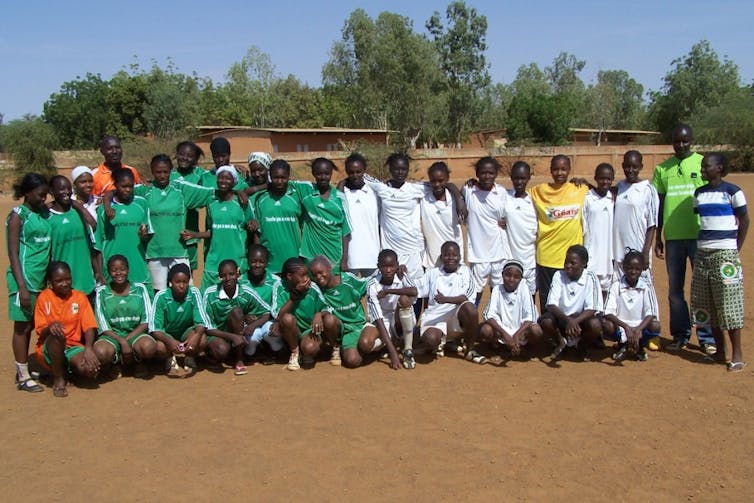The first world football tournament to take place in the aftermath of the FIFA scandals and the resignation of Sepp Blatter, the FIFA Women’s World Cup kicks off in Canada this weekend with no complaints about the host country, the bidding process, corruption or presidential manoeuvering.
The progressive march of women’s football offers a refreshingly different FIFA story from that which has dominated the headlines over the past few weeks. Yet myths about the women’s game continue to exist. Here we attempt to challenge four of the most pernicious.
1. Women’s football is not global
Women’s football is one of the fastest growing sports in the world. It is a myth to suggest that women’s football is not global for it has a growing presence in more than 138 countries.
The FIFA Women’s World Cup is the largest sporting event in the world for women. Since the USA beat Norway 2–1 in the 1991 inaugural World Cup final in front of a crowd of 65,000 people at Guangzhou’s Tianhe Stadium, the competition has doubled in size.
While 12 teams competed in 1991, 24 teams, from six confederations have qualified for the event in Canada: USA, Costa Rica, Mexico, Colombia, Ecuador, Brazil, England, France, Spain, Netherlands, Germany, Switzerland, Norway, Sweden, Nigeria, Cameroon, Cote d’Ivoire, Australia, New Zealand, Thailand, China, Japan, Republic of Korea and the hosts Canada.
The FIFA Women’s world rankings include 138 countries. Of the teams ranked in the top 20 in the world, only Italy, North Korea and Iceland did not qualify.
In development terms, since 2008 FIFA has targeted grassroots development programmes for women in Jordan, Syria, Myanmar, North Korea, Eritrea and Palestine to name but a few places.

2. Women’s football is not popular
The 2014 FIFA survey indicates that women’s football has more than 30 million participants worldwide. In the USA, women dominate the football scene.
Clearly, rates of growth vary across countries. In percentage terms, Romania (668%) and Kazakhstan (900%) have seen the largest increases in registered players over the past five years.
In absolute terms, Turkey (46,353) and the Netherlands (11,734) showed the biggest increases. Europe (UEFA) recorded 1,208,558 registered female players in 2014. FIFA indicates that the number of registered women players is 4,801,360.

3. Women’s football is new
If the purpose of history is to challenge myths based upon new evidence, then it is a myth to suggest that women’s football is new, for clearly it is not.
In 1795, one of the earliest references to a women-only football match is recorded near Musselburgh, Scotland. In 1881, Britain’s first recorded international women’s football match played in Edinburgh. A team representing Scotland beat one from England 3-0, with Lily St Clair scoring the opener.
The first FIFA Women’s World Cup fulfilled a pledge made by then FIFA President João Havelange at the 1986 FIFA Congress in Mexico City. The next hosts of the FIFA flagship competition for women were Sweden (1995), the USA (1999 and 2003), PRC (2007) and Germany (2011).
The tournament has been won twice by Germany and the USA, once each by Japan and Norway and has been part of the football calendar for almost 25 years.
4. Women’s football is not economical
The impact of major sporting events upon local city economies is one of the popular arguments used by cities and governments to rationalise bidding for such events. The rationale is not gender specific since it holds for both men and women’s world cups.
The Minister of Health and Regional Affairs for Northern Alberta, Rona Ambrose, noted that this is the first major sporting event hosted from coast to coast in Canada, with matches to be played in Vancouver, British Columbia, Edmonton, Alberta, Winnipeg, Manitoba, Ottawa, Montreal, Québec and New Brunswick. It is estimated it will have an economic impact of $337 million across Canada.
At grassroots level, if investment is a key to growth then more needs to be done. Global investment in women’s football, in one year, amounted to US $38,934,824.
More specifically, the 2014 survey of women’s football supported the fact that global investment by 177 member associations amounted to an average spend of US $219,971 per association.
What next?
There is much work to do to achieve equality on the football pitch. In claiming to be global, football has to continue to press the case to avoid the charge of being just for some people. The drive for equity and social justice is a social and economic struggle as well as a geo-political one.
Key areas of change that continue to be championed include:
- More media coverage of women’s football
- A more equal distribution of money to develop women’s football
- Ensuring that women of all backgrounds are represented in positions of power and influence.
- Acknowledging that the struggle for women’s football in different countries varies and so needs different support.
- Legislating against sexual discrimination and harassment in through football.
It would clearly be a further myth to accept that equality exists in world football for as current events clearly demonstrate it is inequitable, facing corruption charges, and in simple governance terms lacking in transparency, accountability, and levels of trust that football enthusiasts all over the world can buy into.
Yet the onward march of women’s football is impressive, and much needed in the aftermath of scandal that has shaken the very foundations of the beautiful game.

